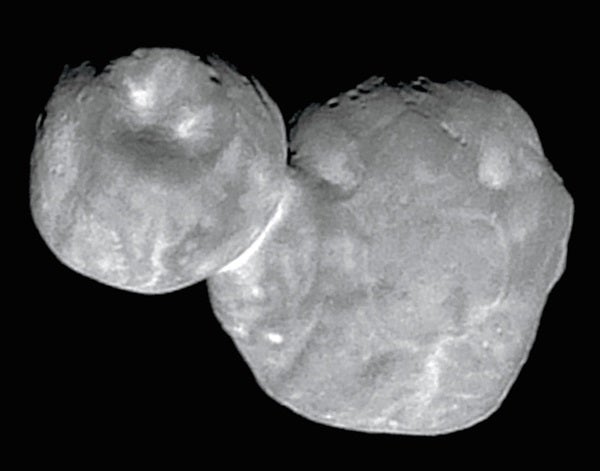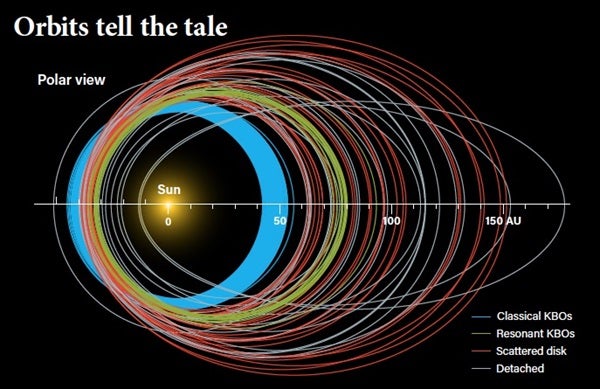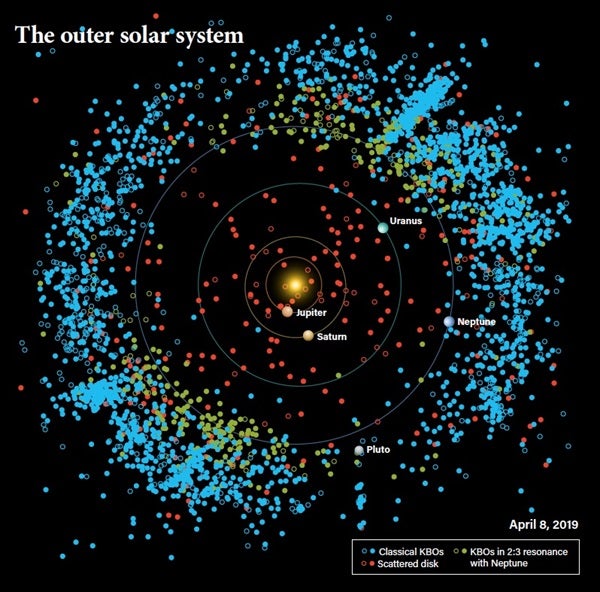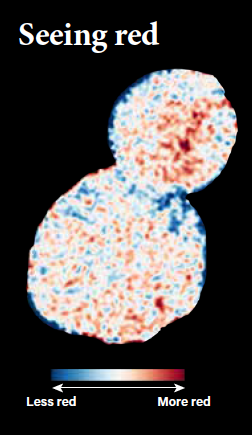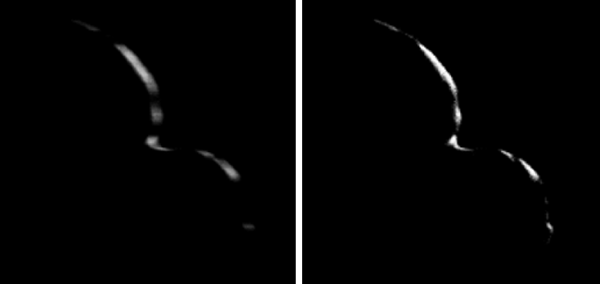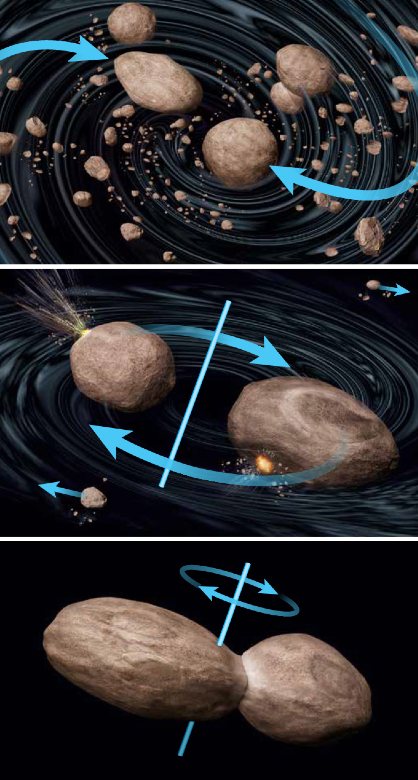KBOs became so important to understanding the formation of our solar system that by 2001, when NASA called for proposals to explore the Pluto system, the space agency required mission teams to include the capability for their spacecraft to go on to explore small KBOs after Pluto. Of the five proposals, NASA selected a team made up of researchers from the Southwest Research Institute and Johns Hopkins University Applied Physics Laboratory, called New Horizons, which I lead. Just two years later, the first Planetary Decadal Survey — chaired by the late planetary scientist Michael Belton — endorsed the exploration of the Pluto system and KBOs as the highest-priority mission to start.
New Horizons was built to be a 21st-century successor to Voyager. It is similarly nuclear powered, but it weighs only about one-third as much, and is equipped with a bevy of advanced scientific instruments: two imagers, infrared and ultraviolet spectrographs, two charged particle spectrometers, radio science instruments, and a dust counter. Because it was built with technologies a generation more advanced, its instruments literally have thousands of times the capability of Voyager. New Horizons also contains solid-state flash-drive memory that can store more than 100 times what Voyager’s tape drive could record.
New Horizons, which cost just one-fifth as much as Voyager, was launched January 19, 2006, toward a February 2007 Jupiter flyby and gravity assist, propelling it on to become, in the summer of 2015, the first mission to explore Pluto and its system of moons. Shortly thereafter, the spacecraft fired its engines to target a flyby with a small KBO planetesimal called 2014 MU69 — later nicknamed Ultima Thule (pronounced “TOO-lee”) — on January 1, 2019, and NASA approved funding for this new chapter in the mission.
Scientists understood little about Ultima Thule before New Horizons arrived. We knew its orbit, its rough size (about 18 miles [30 kilometers] in length), its oblong or perhaps binary shape, its reddish color, and that it lacks large moons.
One key distinction about Ultima Thule is that its type, among the so-called cold classical KBOs, all but guarantees that it originated where it orbits now. So unlike most KBOs, it was not formed closer to the Sun and warmed. Unlike Pluto, Ultima Thule is too small to have sustained strong geologic activity for very long. Because of these two facts, Ultima Thule preserves its primordial nature better than every other object explored by spacecraft. Thus, it presented scientists their first look at what the original, primordial planetesimals of the outer solar system were like when they formed.
Flying to Ultima Thule thus became the planetary exploration equivalent of an unprecedented archaeological dig into the most ancient past of our solar system and the first building blocks of its planets. Although we knew this ahead of time, we didn’t know what the observations of it would reveal. That suspense was a big part of the scientific attraction of the planned flyby.
When you don’t know what you’re going to find, a good way to design your reconnaissance is to keep your eyes as wide open as possible. So we planned to fly much closer to Ultima Thule than we did to Pluto in order to get higher resolution observations. We also planned to use all the scientific instruments aboard, even those that probably wouldn’t find anything. Why? Because if they did surprise us with detections, those revelations would be incredibly valuable.
In addition to our plans to map Ultima Thule at higher resolution than Pluto — in color and in stereo — we also planned to map its surface composition, take its temperature, measure its radar reflectivity, and search for small moons, which are common among cold classical KBOs. We planned to search for an atmosphere as well, though there were sound scientific reasons why one should not exist, and to search for orbiting dust or rings, even though neither had ever been seen around any small KBO.
We even planned to search for Ultima Thule’s effect on the solar wind and charged particle environment, though computer models told us any such effects would be minuscule and undetectable. In effect, we planned to throw everything New Horizons had at exploring Ultima Thule.
What we found
Never before had such a pristine, unmodified object from the birth era of the planets been explored up close, and the results didn’t disappoint.
In another surprise, we found the narrow contact zone between the lobes covered in brighter material of unknown origin and age. We’re still debating whether this bright collar around the binary’s “neck” was created by the merger itself or if it evolved later.
We measured the total length of Ultima Thule at almost precisely 22 miles (35 km), making the KBO about 10 times larger than a typical comet nucleus and — because it is flattened and not spherical — many hundreds of times more voluminous. We dubbed the two lobes Ultima and Thule, with Ultima being the larger one (of course!)
New Horizons measured the average surface reflectivity of Ultima Thule as just 7 percent, which is higher than most cometary surfaces but still darker than garden-variety dirt. That’s just an average, however; the full range goes from about 5 to 12 percent. The object spins once every 15.92 hours, which is typical of other KBOs, but the spin axis is highly inclined to its orbital plane, by about 99°. This explains why we couldn’t detect any change in its brightness in observations made before the flyby with the Hubble Space Telescope or even with New Horizons as the spacecraft approached it in the fall and early winter of 2018.
Team members suspected Ultima Thule might be a contact binary before the New Horizons encounter, but they never expected the two lobes to be so bizarre. This model shows the Kuiper Belt object from three perspectives. In the top view, the spin axis points toward us. This closely matches the probe’s pre-encounter perspective. In the side view, the body’s long axis faces us. It is the front view, however, that gives us the best look at the lobes’ shapes.
What we didn’t find
We didn’t expect Ultima Thule to have an atmosphere because any surface ices volatile enough to sublimate and make such gases would have long since escaped, and we didn’t find one. We also searched for evidence of satellites and rings. Many KBOs have satellites, particularly among the cold classical KBO group to which Ultima Thule belongs. A few current or escaped KBOs even have rings. But Ultima Thule is devoid of both. Although that disappointed some team members, Ultima Thule made up for it in spades with other surprises that charmed us.
Among them are its varied geology and surface markings. Ultima Thule shows differing terrain types on its two lobes and a wide variety of relatively bright linear features and spots laced across its surface with no clear pattern. We discovered a few craters that probably formed through impacts, most notably the large one that dominates the smaller Thule lobe.
Our observations found other surface pits too, but their similar sizes and close association to one another, sometimes in chains, leads us to believe these are more likely sublimation or collapse pits created internally, rather than externally generated impact craters. In addition, on the big lobe Ultima, we discovered eight like-sized regions that dominate the lobe and abut one another, and are usually separated by brighter boundaries. Whether these are some of the smaller bodies Ultima formed from or instead created geologically after Ultima (or even the Ultima Thule binary) formed is hotly debated.
Close examination of the binary’s two lobes didn’t reveal any fractures or other signs of a violent collision between them. Their apparently gentle merger leads us to believe they formed in the same individual “collapse cloud” of the ancient solar nebula. This hypothesis is further supported by the lobes’ similar reflectivities, colors, and compositions.
The fact that Ultima Thule is a contact binary tells us that many KBOs are likely to have this form, something else that modelers will have to explain. But Ultima Thule’s highly tilted spin axis will make this more difficult because most current models for KBO formation predict spin axes that are more “up and down” with respect to the solar system’s plane, as one would expect from the angular momentum of the solar nebula itself.
It’s cliché to say that the findings about Ultima Thule will keep us busy for years trying to understand them, but that’s exactly the case!
What Ultima Thule can teach us
The findings to date are shedding light on other KBOs, particularly those of the cold classical population. For example, the heterogeneous geology of the Ultima lobe tells us to expect that other KBOs also may contain clues to how they were assembled and how they may have evolved in their youth. Moreover, the fact that Ultima Thule apparently has no satellites could be telling us that KBOs that evolve to be contact binaries may have ejected all their satellites in the very process of orbital evolution that brings the two lobes of such bodies together.
In addition, crater counts on Ultima Thule are shedding new light on the small-body KBO population crossing its orbital range, which extends from 43 to 45 astronomical units from the Sun. (One astronomical unit [AU] is the average Sun-Earth distance.) This will allow us to probe the KBO population down to sizes much too faint to detect with any existing or currently planned telescopes. The lack of exposed volatile ices such as molecular nitrogen, carbon monoxide, and methane — all of which have been seen on Pluto and some other dwarf planets — appears to confirm our models that small KBOs, which have much lower gravity than dwarf planets, cannot hold onto the atmospheres that naturally would form by the sublimation of such volatiles. Thus, the surfaces of small KBOs like Ultima Thule apparently “dry out” soon after forming.
But just like the first missions to each of the planets, and to asteroids and comets, New Horizons could not tell us everything we want to know about dwarf planets or KBOs. This is because New Horizons carried a limited payload, which could not address many aspects of KBO and dwarf planet science because other kinds of spectrometers, atmospheric instruments (for Pluto), radars and lidars, and thermal mappers need to be brought to bear.
Also, New Horizons visited only one of the many dwarf planet systems of the Kuiper Belt, and will at most be able to visit a second small KBO on its existing fuel supply — not the full diversity of such objects. Together, these reasons limit what we can learn from New Horizons, and beg for new missions in the 2020s to fly by new dwarf planets and small KBOs, and to orbit Pluto.
The most common question I get about New Horizons is about its future. It’s a tribute to the spacecraft’s designers, builders, and flight team that New Horizons is healthy and operating essentially perfectly, even in its 14th year of flight.
We hoped this would be the case because New Horizons has the capability, if no serious malfunctions occur, to fly for another 15 or more years — out to a distance of more than 90 AU — before its power levels drop too low. It’s also worth noting that New Horizons has the communication capability to operate much farther out, so if we can devise ways to run on even lower power levels than we now think possible, an even longer life and more distant exploration could be in the cards.
But New Horizons is funded to operate only until mid-2021. Between now and then, its tasks are to complete the downlink of all its Ultima Thule flyby data (which won’t be finished until late summer 2020); collect context observations of other KBOs it passes in the distance; and survey the Kuiper Belt’s radiation, solar wind, and dust environment out to 50 AU — the outer limit of Pluto’s orbit.
To go farther into the Kuiper Belt, our team will need to propose and win funding for a second extended mission from NASA. In fact, because the standard at NASA is for extended missions to compete for funding every three years, the New Horizons team will ultimately have to propose and win science extensions five or more times before the mid-2030s, when we expect its power levels will dwindle too far to continue to do good science.
Our 2020 extended mission proposal will focus in part on pushing both the radiation and dust surveys, and the observations of KBOs we pass in the distance, out to not 50 but 60 AU, which is still inside the 70 AU outer limit of the Kuiper Belt as we know it. But there is also the exciting possibility for our next mission extension to fly by one more KBO, much farther out than Ultima Thule.
The primary limiting factor in the feasibility of such a flyby is the amount of fuel remaining. Fortunately, our engineers estimate that in 2021, when the next extended mission of New Horizons would begin, there will be more fuel left in the tank than it took to do the targeting of Ultima Thule.
So, later this year, once we complete the current phase of intensive data analysis on Ultima Thule, the New Horizons team will start to evaluate how we can use large ground-based telescopes, the Hubble and James Webb space telescopes, and even our sensitive onboard telescopic camera called LORRI, to find a new flyby target within our “fuel reach.”
I can’t predict the outcome. We simply have to do the work before we know the answer. So stay tuned for news about future flyby prospects!

